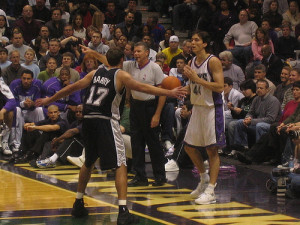Why use a Zone Defence against a Baseline Out of Bounds?

A Baseline Out of Bounds situation can be very challenging to defend and one strategy to limit the options available to an offensive team is to employ a Zone Defence. A zone defence brings a number of positives to a team’s defensive orientation in the half court. Some of these benefits can carry over to out-of-bounds scenarios. The effectiveness however of a zone defence is underpinned, like all defences, on the team’s ability to implement the defensive principles to their most effective end. Without every player on the floor participating and playing their part, a zone defence will still be ineffective just as much as any other defence.
Simplicity

For defensive sides struggling to maintain good spacing and marking during an inbounding situation a zone defence can be a good alternative. Because a zone defence allocates certain positions on the court as well as giving very specific roles to each player. Each individual is more likely able to perform their expected role to a higher level of competence. The free-flowing nature of man-to-man defence can sometimes confuse players especially against tactical elements like screen the screener and players screening to get free. Utilising a zone defence takes away some of this uncertainty against a baseline situation and plants defenders into specific roles.
Less Moving Parts
A zone defence by its nature as described above has less movement because defensive players are reacting to activity in their area, not just simply the individual player movement of whom they are matched up against. Less movement by individual defenders should see an improvement in vision (provided players are still maintaining lines of sight), reaction time (provided players are in a ready stance) and decision-making. If this is not the case, and a team’s zone defence is still ineffective against a baseline play. It might be time to focus on individual defensive awareness and technique.
Less movement does not equal not being defensively aware. Zone defenders still need to be accountable to knowing where the shooters are and other key players respective to their areas of responsibility on the court.
Condenses Defenders
A reduction in the space between defenders is also another benefit of implementing a zone defence against a baseline out-of-bounds play. Baseline plays nearly always have a theme of creating a shooting opportunity if the X’s and O’s play out right. For a majority of these players the primary and secondary scoring options happen around or in the keyway. Employing a zone defence brings players into the keyway and floods this area of the court with bodies. Provided players look to shut down passing lanes by being active in defence they should be able to reduce the margin for an opportunity to occur.
One of the constant problems with this line of thinking concerning a zone defence is that individual defenders still need to be active. Too many times a team switches to a zone defence, and then the individuals fail to remain active and disciplined in employing defensive principles. Using a zone defence is not about resting individuals, it is just a different tactic.
Rebounding
Player’s proximity to the basket will decrease in a zone defence. This must be seen as an advantage for players to initiate and establish defensive positioning when rebounding. Again, this is reliant on players taking up this advantage and not seeing it is a fore gone conclusion that because they are closer to the basket they are entitled to the ball.
A zone defence can be very effective against a particularly potent offense generated when inbounding from the baseline. The zone defence can also be used as a way of bluffing a team into setting up in their zone offense before changing to man-to-man. This can be a useful strategy during an inbound to help players match-up and slow the tempo at which the offense is running.






Leave a Reply